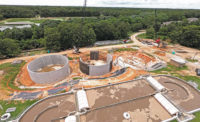Wastewater utilities and scientists around the world are using advances in epidemiological technology specific to wastewater to track the coronavirus, says John Norton, director of energy, research and innovation at the Great Lakes Water Authority near Detroit.
The agency, along with the Detroit Water and Sewerage Dept., is participating in a Michigan State University study to measure the virus—both its genetic signal and active form—in wastewater.
Recent studies suggest that some cells of active virus remain in fecal matter, but they quickly degrade once in the sewer. What scientists and engineers are finding more typically are genetic “signals” of the SARS-COv2—molecular fragments of ribonucleic acid (RNA) chains that can be recognized as the virus—in wastewater systems, Norton says.
Boston-based Biobot, a data analytics firm for wastewater systems, is currently working with approximately 400 facilities in 42 states across the U.S. to help wastewater utilities, along with public health officials, make predictions about public health trends, such as whether COVID-19 is likely to spread or decrease in specific counties and cities.
Mariana Matus, CEO and co-founder of Biobot, says collecting data from sewage will enable communities to measure the scope of the outbreak, independent of patient testing or hospital reporting. “Better understanding of the scope provides decision support for officials,” she says.
Allegra da Silva, a senior environmental engineer at Brown and Caldwell, notes that studies consistently show wastewater treatment processes are effective in eradicating viruses and bacteria that are even stronger in their molecular structure than coronaviruses.
COVID-19 is surrounded by a layer of fat, which degrades quickly when treated even with common disinfectants such as bleach, she says. Some viruses are encapsulated with tougher protein shells, which are harder to eradicate.
“We have a lot of confidence and data that show that enveloped viruses like COVID are well disrupted” by treatment, she says.



Post a comment to this article
Report Abusive Comment